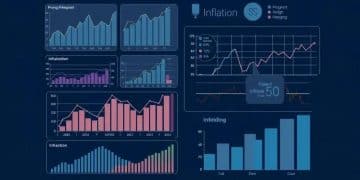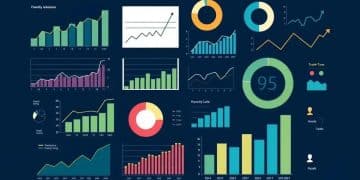Best retirement savings plans in 2025 that you need

The best retirement savings plans in 2025 include options like 401(k)s and IRAs, emphasizing the importance of early contributions, diversified investments, and low fees to maximize savings effectively.
Best retirement savings plans in 2025 can make a significant difference in your future financial security. With so many options available, have you wondered which ones will truly benefit you? Let’s dive into the most effective strategies today.
Understanding retirement savings plans
Understanding retirement savings plans is essential for anyone looking to secure their financial future. With various options available, knowing the basics can greatly impact your savings strategy.
Types of retirement savings plans
There are several plans to consider when planning for retirement. Each type has distinct features that may benefit different individuals based on their needs.
- 401(k): This is a popular employer-sponsored plan that allows employees to save a portion of their paycheck before taxes.
- IRAs (Individual Retirement Accounts): IRAs come in two main types, traditional and Roth, each with unique tax advantages.
- SEP IRA: Designed for self-employed individuals, this plan provides a simple way to contribute to retirement.
- Defined Benefit Plans: These plans promise to pay a specific amount upon retirement based on earnings and years of service.
Understanding these options helps you make informed choices about where to allocate your resources. Furthermore, many retirement plans provide company matching, which can enhance your savings significantly. If your employer offers a match, make sure to take full advantage of it.
Long-term vs. short-term goals
Another important aspect to consider is your investment time horizon. Are you closer to retirement, or do you have years to grow your money? For long-term goals, investing in stocks within your retirement savings plan may yield higher returns, while short-term goals might focus on more secure investments.
Additionally, regularly reviewing your retirement savings plan is crucial. Adjusting your contributions and investment choices based on changes in your life circumstances, such as raising a family or changing jobs, can help keep you on track.
Key features of the best retirement plans

Understanding the key features of the best retirement plans is essential for making informed financial decisions. These features help you identify which plans will best meet your retirement needs.
Flexibility in contributions
One of the most important aspects of retirement plans is the ability to adjust your contributions. Many plans let you change how much you save each year based on your financial situation.
- Employer matching: Some employers match your contributions, which can significantly boost your savings.
- Catch-up contributions: If you’re over a certain age, you might be eligible to contribute more to your plan.
- Automatic escalation: This feature allows your contributions to increase automatically each year, helping you save more without needing to think about it.
In addition to flexibility, the growth potential of your investments plays a pivotal role. Many retirement plans allow for investment in stocks, bonds, and mutual funds. This can lead to significant accumulation of wealth over time.
Tax advantages
Another crucial feature is the tax benefits associated with retirement plans. Depending on the plan type, you may find varying levels of tax advantages. For instance, contributions to a traditional 401(k) may be tax-deductible, while withdrawals are taxed in retirement.
In contrast, Roth IRAs involve contributions made with after-tax money, meaning withdrawals in retirement are tax-free. Understanding these tax implications can help you maximize your retirement savings.
Your retirement plan should also be easily accessible. Look for plans that offer online management tools, allowing you to track your funds and make adjustments easily. With technology today, managing your savings has never been simpler, making it vital to choose plans that prioritize user-friendly experiences.
How to choose the right retirement plan
Choosing the right retirement plan can feel overwhelming. With various options available, it’s important to consider a few key factors to ensure that your choice aligns with your financial goals.
Assess your retirement goals
Start by asking yourself what you want your retirement to look like. Are you hoping to travel, downsize, or maybe start a new hobby? Knowing your goals will help you determine how much you need to save.
- Calculate your expenses: What will your monthly living costs be? Include housing, healthcare, and leisure activities.
- Set a target savings amount: Your goal will dictate how much you need to save each month.
- Consider your lifestyle: Think about the lifestyle you want to maintain. Will you need more funds for travel or activities?
With your goals in mind, review different plan options. For example, a 401(k) might be ideal if your employer offers matching contributions, while an IRA may provide more investment flexibility.
Evaluate fees and expenses
Fees can erode your retirement savings, so it’s essential to understand the costs associated with each plan. Compare expense ratios, management fees, and any withdrawal penalties.
Additionally, ask about hidden fees that may not be obvious at first glance. Plans with lower fees can lead to more growth over time, so don’t overlook this important factor.
Finally, consider flexibility. Select a plan that allows you to change your contributions or investment options as your circumstances evolve. This adaptability can significantly impact your savings journey.
Tips for maximizing your retirement savings

Maximizing your retirement savings is crucial for ensuring a comfortable future. With the right strategies, you can significantly increase the amount you save over time.
Start early and contribute regularly
One of the best ways to maximize savings is to start early. The earlier you begin contributing to your retirement plan, the more time your money has to grow.
- Take advantage of compound interest: The sooner you invest, the more you benefit from interest on your initial investment.
- Set up automatic contributions: Automate your contributions to ensure you save regularly without thinking about it.
- Increase contributions over time: As you receive raises or bonuses, consider increasing your retirement contributions.
Consistent saving habits lay a solid foundation for your future. Additionally, monitoring your spending can free up more money for savings.
Choose the right investments
Your investment choices within your retirement plan can have a huge impact on your overall savings. Diversification is key. By spreading your investments across different asset classes, you can reduce risks and potential losses.
Consider a mix of stocks, bonds, and mutual funds to create a balanced portfolio. Stocks typically offer growth potential, while bonds can provide stability during market fluctuations. Regularly reviewing and adjusting your investment strategy based on performance is also essential.
Furthermore, be mindful of your plan’s fees. High fees can eat into your savings over time, so look for low-cost investment options that still provide good returns. Keeping fees low allows you to keep more of your money working for you.
FAQ – Frequently Asked Questions about Retirement Savings Plans
Why is it important to start saving for retirement early?
Starting to save for retirement early allows your money to grow with compound interest, significantly increasing your savings over time.
What are some effective strategies for maximizing retirement savings?
Effective strategies include starting early, automating your contributions, diversifying investments, and regularly monitoring fees.
How can I choose the right retirement plan for my needs?
Assess your retirement goals, evaluate different plan options, and consider factors such as fees, flexibility, and investment choices to find the best fit.
What types of investments should I include in my retirement plan?
Consider a mix of stocks for growth, bonds for stability, and low-cost mutual funds to create a balanced investment portfolio that aligns with your risk tolerance.





